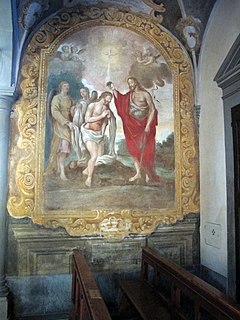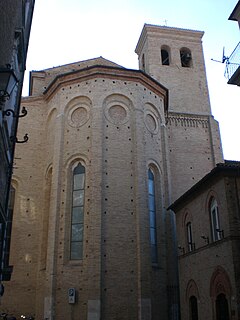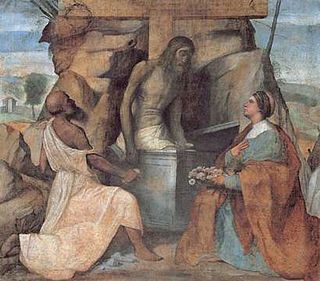Santa Maria Assunta is Roman Catholic parish church located in the town of Pievepelago in the region of Emilia-Romagna, Italy.

Santa Maria Assunta is Roman Catholic parish church located in the town of Pievepelago in the region of Emilia-Romagna, Italy.

A parish church at the site is documented since 1038, but little remains of that building. Construction of the present parish began 1868 designed by Cesare Costa, and was consecrated in 1874. The church houses a Glory of Santa Filomena by Adeodato Malatesta. [1]
The counter facade has paintings depicting St Francis and the Immaculate Conception (1918) by Gaetano Bellei. The left transept has a reliquary urn for St Theodore in Neocalssic style by Gaetano Boccini. The main chapel has an altarpiece depicting the Virgin in Glory by the painter Carlo Rizzi. The church also houses a St Luigi Gonzaga (1853) by Luigi Asioli. Beside the church is the Oratory of San Luigi, built in 1754, and the Oratory of the Bianchi, built under the patronage of the empress of Austria in the late 1700s. [2]

Diano Castello is a comune (municipality) in the Province of Imperia in the Italian region Liguria, located about 90 kilometres (56 mi) southwest of Genoa and about 5 kilometres (3 mi) northeast of Imperia. As of 31 December 2004, it had a population of 2,061 and an area of 6.0 square kilometres (2.3 sq mi).

Busnago is a comune (municipality) in the Province of Monza and Brianza in the Italian region Lombardy, located at a distance of 30 kilometres (19 mi) northeast of Milan.

The Church and Convent of the Girolamini or Gerolamini is a church and ecclesiastical complex in Naples, Italy. It is located directly across from the Cathedral of Naples on via Duomo. The facade is across the homonymous piazza and street from Santa Maria della Colonna. It is one block west of Via Duomo.

Santa Maria in Campitelli or Santa Maria in Portico is a church dedicated to the Virgin Mary on the narrow Piazza di Campitelli in Rione Sant'Angelo, Rome, Italy.

The Shrine of Santa Maria della Steccata is a Greek-cross design Renaissance church in central Parma, Italy. The name derives from the fence or steccato used to corral the numerous devotees who visited a venerated image of the Madonna.

Giovanni Giacomo Barbelli was an Italian painter of the Baroque period, active in Lombardy. He was a canvas and fresco painter known for his religious and mythological scenes that decorate many churches and residences in Lombardy. He was a highly skilled draughtsman and a brilliant colorist. His work shows an inventive imagination and a thorough knowledge of perspective.

The National Art Gallery of Bologna is a museum in Bologna, Italy. It is located in the former Saint Ignatius Jesuit novitiate of the city's University district, and inside the same building that houses the Academy of Fine Arts. The museum offers a wide collection of Emilian paintings from the 13th to the 18th century and other fundamental works by artists who were in some way related to the city.

Santi Bartolomeo e Gaetano is a Renaissance style, Roman Catholic church in central Bologna; it is located near the Due Torri adjacent to the Strada Maggiore.

Anton Domenico Bamberini (1666–1741) was an Italian painter, mainly of religious Baroque frescoes in churches completed in a heavily ornamented and stuccoed trompe-l'œil frames and settings.

The Church of the Theatines (Teatini), also known as Santa Maria della Pietà is a Roman Catholic, Baroque-style church and monastery located on Corso della Giovecca, in central Ferrara, region of Emilia-Romagna, Italy.

San Filippo Neri is a late-Baroque style, Roman Catholic church located in Turin, region of Piedmont, Italy. The church is located on Via Maria Vittoria 5; the left flank of the nave faces the Turin Academy of Sciences. The church is still used for services. 69 metres (226 ft) long and 37 metres (121 ft) wide, it is the largest church in the city of Turin.

The Complesso di San Firenze is a 17th-century Baroque-style building, consisting of a church, palace, and former oratory, located on the southeast corner of the saucer-shaped piazza of San Firenze, located in the quartiere of Santa Croce in central Florence, region of Tuscany, Italy. The buildings were commissioned by the Oratorians of Saint Philip Neri.

Sant'Agostino is a Romanesque-Gothic-style Roman Catholic church located in Via Cairoli in Rimini, Italy. It is one of the older extant church buildings in Rimini.

Santi Stefano e Niccolao or Stefano e Nicolò is a Roman Catholic church located in Pescia, region of Tuscany, Italy.
Santa Maria Assunta is Roman Catholic parish church located in the frazione of Cinghianello, outside of the town of Polinago in the region of Emilia-Romagna, Italy.

San Giuseppe da Copertino is a Roman Catholic basilica church in the town of Osimo, region of Marche, Italy.

San Michele e San Francesco is a renaissance-style, Roman Catholic parish church located in the Piazza SS Francesco e Michele in the town of Carmignano, province of Prato, region of Tuscany, Italy. It is best known for housing the Jacopo Pontormo altarpiece of the Visitation.
San Nicolò is a Neoclassical-style, Roman Catholic church located on in the town of Isola Dovarese in the province of Cremona, region of Lombardy, Italy.

The Parish Church of St Cajetan of Thiene is a Roman Catholic parish church in Ħamrun, Malta, dedicated to Saint Cajetan. The church was constructed between 1869 and 1875 to designs of Giorgio Costantino Schinas, in a combination of architectural styles. The oratory and dome were added later on in the 1890s and 1950s; the latter was designed by Andrea Vassallo and it was constructed under the direction of Ġużè Damato.

The Dead Christ Adored by Saint Jerome and Saint Dorothy or Saint Jerome and Saint Dorothy Adoring Christ in the Tomb is a 1520-1521 tempera verniciata on canvas painting by Moretto da Brescia. It is on show above the left-hand side door to the church of Santa Maria in Calchera in Brescia, though it is not thought to have originally been produced for that church as neither Jerome nor Dorothy had an active cult in that parish and they rarely appear in art together.